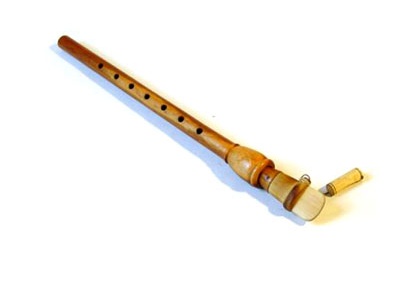Balaban/Bülban
Woodwinds
Asia
Between 1001 and 1900 AD
Video
The Balaban (also known as Bülban in some regions) is a cylindrical, double-reed woodwind instrument originating from the Caucasus and Middle East, particularly Azerbaijan. It is a traditional instrument, known for its warm, mellow, and plaintive sound, which makes it well-suited for emotional and lyrical music. The Balaban is typically made of apricot or mulberry wood and has a simple, straightforward design.
Purpose of Usage
The Balaban is primarily used for:
It is a key instrument in Azerbaijani, Turkish, and other regional folk traditions. Played at weddings, funerals, and other life-cycle events to evoke emotional depth and complement traditional rituals. In Azerbaijani mugham and similar genres, the Balaban is an integral part of ensembles, providing melodic and emotional depth. The Balaban’s expressive sound makes it a preferred choice for improvisational solos. It often accompanies narrative performances, emphasizing the mood and themes of the story.
Uses
The Balaban’s versatility allows it to be used in various contexts, including:
- Solo performances.
- Accompaniment for vocalists or other instruments.
- Ensemble playing in folk, classical, and ceremonial settings.
- Fusion music, where traditional instruments are blended with modern genres.
How It Works
The Balaban is a double-reed instrument. Its sound is produced as follows:
The player blows air through a reed inserted into the top of the instrument. The reed’s vibration generates the sound. The cylindrical body of the instrument amplifies and shapes the sound. The Balaban typically has 8-9 finger holes on the front and one thumb hole on the back. Players cover or uncover these holes to produce different pitches. Skilled players use precise breath control to vary dynamics, sustain notes, and achieve expressive phrasing.
Characteristics and Key Features
Traditionally crafted from dense woods like apricot, mulberry, or walnut, which contribute to its warm tone. The instrument is about 28–35 cm long, though variations exist. Characterized by a deep, warm, and slightly nasal tone, suitable for conveying a wide range of emotions. The reed (called “gamish”) is made of cane and plays a crucial role in sound production. It is often tied to a small metal or wooden tube. The instrument requires a steady and controlled airflow, and circular breathing is often employed for continuous playing.
Types
Traditional Balaban: The most common form, used in folk and classical music.
Alto Balaban: A slightly larger version with a deeper range, used for more dramatic or somber pieces.
Tenor Balaban: A less common variation, offering an even lower tonal range.
Customized Variants: Some modern versions may include keys for easier playability or different designs to suit specific regional styles.
History
The history of the Balaban dates back centuries, with its origins rooted in the musical traditions of the Caucasus, Azerbaijan, and Turkey. Historical evidence suggests that similar instruments existed as early as the 9th-12th centuries. It evolved alongside other double-reed instruments like the duduk (Armenian) and zurna (Turkish).
The Balaban became a symbol of Azerbaijani musical heritage and has been used in traditional ensembles, notably in the performance of mugham, a sophisticated and highly expressive musical form.
Origin (Country and Year)
The Balaban is believed to have originated in Azerbaijan or the Caucasus region. While its exact inception date is unclear, historical references place its development around the 10th century CE or earlier. The instrument shares similarities with the duduk and other double-reed instruments of the Middle East and Central Asia, indicating a shared or parallel evolution.
Significance
The Balaban holds cultural, musical, and historical importance. It is a vital symbol of Azerbaijani and broader Caucasian culture, representing the emotional depth of the region’s music. Essential in the preservation and performance of mugham and folk music, it serves as a bridge between past and present. The Balaban’s rich and soulful sound makes it a powerful medium for conveying human emotions, resonating with audiences worldwide. Despite its ancient roots, the Balaban continues to find its place in contemporary music, including world and fusion genres.
The Balaban is a remarkable instrument that embodies the rich cultural and musical heritage of Azerbaijan and the Caucasus. With its evocative sound and timeless appeal, it continues to captivate listeners and inspire musicians across generations. Its deep roots in tradition and ongoing relevance in modern music make it a true cultural treasure.
FAQ
What are the historical origins of Balaban?
The balaban is a traditional wind instrument that originated in the Caucasus region, particularly among the peoples of Azerbaijan, Armenia, and Georgia. It has deep roots in the ancient music of these cultures and is thought to have evolved from earlier instruments like the surnay or zurna, which were used in both folk and ceremonial contexts. The balaban is characterized by its rich, reedy sound and typically features a cylindrical body and a double-reed mouthpiece.
What materials are typically used to craft Balaban instruments?
The aulos played a significant role in the cultural practices of ancient Greece, serving as both a musical and symbolic instrument. It was commonly used in religious ceremonies, particularly in worship of gods like Dionysus and Apollo, where its vibrant, piercing sound evoked divine presence and ecstasy.
What are the historical origins of Balaban in different regions?
The balaban has distinct historical origins across different regions, each contributing to its unique cultural role. In Azerbaijan, the balaban evolved from earlier wind instruments like the zurna, becoming an integral part of folk music and ceremonies. In Armenia, the instrument has roots in ancient double-reed traditions, often associated with pastoral life and celebrations.
How does the circular breathing technique enhance the sound of Balaban?
The circular breathing technique greatly enhances the sound of the balaban by allowing the player to produce a continuous, uninterrupted tone. This technique involves inhaling through the nose while simultaneously exhaling through the mouth, enabling the musician to maintain a steady, flowing sound without pausing for breath.
 Links
Links
References
Other Instrument
Categories


















